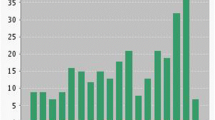Abstract
Meaningful life is emotionally marked off. That’s the general point that Johansen (IPBS: Integrative Psychological & Behavioral Science 44, 2010) makes which is of great importance. Fictional abstractions use to make the point even more salient. As an example I’ve examined Borges’ famous fiction story. Along with the examples of Johansen it provides an informative case of exploring symbolic mechanisms which bind meaning with emotions. This particular mode of analysis draws forth poetry and literature in general to be treated as a “meaningful life laboratory”. Ways of explanation of emotional effect the art exercises on people, which had been disclosed within this laboratory, however, constitute a significant distinction in terms that I have designated as “referential” and “substantive”. The former appeals to something that has already been charged with emotional power, whereas the latter comes to effect by means of special symbolic mechanisms creating the emotional experience within the situation. Johansen, who tends to explain emotions exerted by the art without leaving the semiotic perspective, is drawn towards the “referential” type of explanation. Based upon discussions in theory of metaphor and Robert Witkin’s sociological theory of arts it is demonstrated an insufficient of “referential” explanation. To overcome a monopoly of “referential” explanation of emotional engagement, in particular, in literature, means to break away from the way of reasoning, stating endless references to “something else”, presupposing the existence of something already significant and therefore sharing its effects.
Similar content being viewed by others
Notes
It’s should be marked, however, that to provide thinking-like operations there could be another means of distinction. For example, it could be the formal logic, implemented via technical devices. I’m not intending to discuss the problem of artificial intellect here, though.
References
Black, M. (1962). Metaphor—models and metaphor. Studies in language and philosophy (pp. 25–47). Ithaca, London: Cornell University Press.
Borges, J. L. (1962). Funes, the memorious // Ficciones (pp. 107–116). New York: Grove Press.
Douglas, M. (1988). Purity and danger: an analysis of the concepts of pollution and taboo. London: Ark Paperback. original 1966.
Durkheim, E. (1973). The dualism of human nature and its social conditions. In R. Bellah (Ed.), E. Durkheim. On morality and society. Selected writings (pp. 149–163). Chicago: University of Chicago Press.
Durkheim, E. (1983). Sociology and pragmatism. Cambridge: Cambridge University Press.
Durkheim, E. (1995). The elementary forms of religious life. New York: The Free Press.
Girard, R. (1995). Violence and the sacred. London: The Athlone Press.
Johansen, J. D. (2010). Feelings in literature. IPBS: Integrative Psychological & Behavioral Science, 44(3).
Park, R. (1967). The city as a social laboratory. In R. H. Turner (Ed.), On social control and collective behavior: Selected papers (pp. 3–18). Chicago: University of Chicago Press. 1929.
Peirce, C. S. (1992). How to make our ideas clear. In N. Houser & C. Kloeser (Eds.), The essential Peirce: Selected philosophical writings, vol. 1 (1867–1893) (pp. 124–141). Bloomington: Indiana University Press.
Ramanujan, A. K. (1973). Speaking of Siva. London: Penguin Classics.
Riсоеur, P. (1978). The metaphorical process as cognition, imagination, and feeling. Critical Inquiry, 5(1), 143–159.
Turner, V. (1969). The ritual process: Structure and anti-structure. Chicago: Aldine.
Turner, V. (1975). Metaphors of anti-structure in religious culture // dramas, fields and metaphors. Symbolic action in human society (pp. 272–299). Ithaca: Cornell University Press.
Witkin, R. W. (2005). A new paradigm for a sociology of aesthetics. In D. Inglis & J. Hugson (Eds.), Sociology of arts: Ways of seeing (pp. 57–72). New York: Palgrave Macmillan.
Witkin, R. W. (2006). Chewing on Clement Greenberg. Abstractions and the two faces of modernism. In R. Eyerman & L. McCormick (Eds.), Myth, meaning and performance: Toward a new cultural sociology of the arts (pp. 35–50). Boulder: Paradigm Publishers.
Author information
Authors and Affiliations
Corresponding author
Rights and permissions
About this article
Cite this article
Kurakin, D. Literature as a Meaningful Life Laboratory. Integr. psych. behav. 44, 227–234 (2010). https://doi.org/10.1007/s12124-010-9138-3
Published:
Issue Date:
DOI: https://doi.org/10.1007/s12124-010-9138-3




